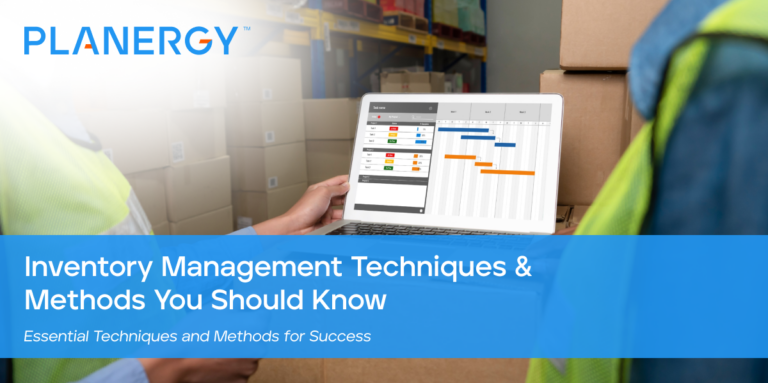Effective inventory management is crucial for the success of any business, whether it’s a small startup or a large enterprise.
Managing inventory effectively can reduce costs, improve cash flow, and boost customer satisfaction.
In this blog post, we will explore various aspects of inventory management, including its importance, different types of inventory, major techniques, best practices, and the latest trends in inventory management technology.
What is Inventory Management?
Inventory management refers to ordering, storing, using, and selling a company’s inventory.
This includes managing raw materials, components, and finished products, as well as warehousing and processing such items.
Effective inventory management ensures a business has the right products in the right quantities at the right time.
How Can Businesses Benefit from Inventory Management?
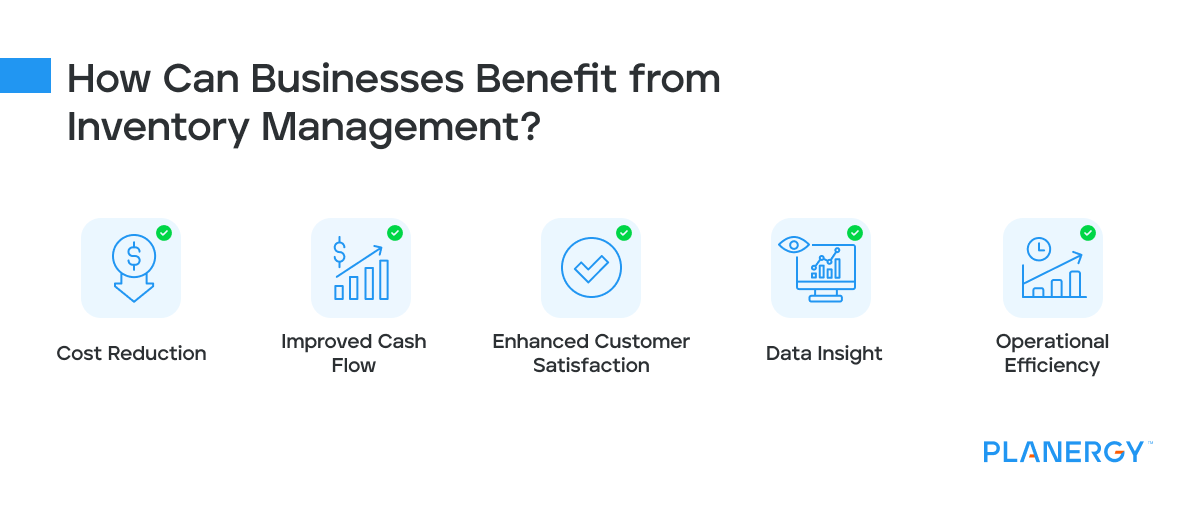
Cost Reduction
By keeping optimal inventory levels, businesses can reduce storage costs and minimize excess or obsolete stock.
This means that money isn’t tied up with unsold products, and companies can avoid the financial burden of maintaining large warehouses.
Efficient inventory management also prevents overproduction, which results in wasted resources and capital.
Improved Cash Flow
Efficient inventory management helps maintain a balance between too much and too little stock, positively influencing cash flow.
When stock levels are optimized, businesses can reinvest the capital saved from reduced inventory costs into other business areas, fostering growth and development.
Enhanced Customer Satisfaction
Having the right products available when customers need them improves service levels and customer satisfaction.
Timely order fulfillment leads to positive customer experiences, repeat business, and brand loyalty.
Proper inventory management ensures that high-demand products are always in stock, reducing the chances of disappointing customers with stockouts.
Data Insight
Inventory management provides valuable insights into sales patterns, which can be used for better forecasting and planning.
By analyzing data trends, businesses can predict seasonal demands, adjust marketing strategies, and make informed decisions about product restocking and phase-outs, leading to more strategic and effective operations.
Operational Efficiency
Streamlined operations avoid overstocking or stockouts, leading to smoother production processes.
Efficient inventory management ensures that production lines are not halted due to a lack of materials and helps manage lead times effectively.
This results in a more reliable and predictable production schedule.
4 Types of Inventory
Raw Materials
Raw materials are the basic substances or components used to produce finished goods.
They can be natural resources, chemicals, parts, or any other material processed or assembled during production.
Examples:
- A furniture manufacturer’s raw materials might include wood, nails, glue, and fabric.
- A bakery’s raw materials consist of flour, sugar, eggs, and butter.
Managing raw materials efficiently ensures a smooth production process.
Adequate stock levels are crucial to avoid production delays while overstocking can tie up capital and increase storage costs.
Best Practices:
- Accurate Forecasting: Use historical data and market trends to predict the required amount of raw materials.
- Supplier Relationships: Maintain strong relationships with reliable suppliers to ensure timely delivery of quality materials.
- Quality Control: Implement stringent quality checks to avoid production issues caused by substandard raw materials.
Work-in-Progress (WIP)
Work-in-progress inventory consists of items that are being manufactured but are not yet complete.
These items have been partially worked on, and additional labor or materials are required to turn them into finished goods.
Examples:
- Car components on an assembly line that are halfway through the manufacturing process.
- Dough being mixed and shaped before baking in a bakery.
Effectively managing WIP inventory ensures that production processes run smoothly and efficiently.
Monitoring WIP is essential to prevent bottlenecks and ensure timely product completion.
Best Practices:
- Streamline Production Processes: Optimize workflows to reduce idle time and improve efficiency.
- Regular Monitoring: Keep track of WIP stages and progress to promptly identify and address any delays.
- Lean Manufacturing: Implement lean manufacturing principles to minimize waste and improve the flow of materials through the production process.
Finished Goods
Finished goods are completed products that are ready for sale to customers.
These items have passed through the entire production process and are now stored as inventory until they are sold.
Examples:
- A completed piece of furniture ready for delivery to a customer.
- Packaged bread ready for sale in a bakery’s retail outlet.
Proper management of finished goods inventory is vital to meet customer demand and drive sales.
Overstocking can lead to increased holding costs and potential obsolescence, while understocking can result in missed sales opportunities.
Best Practices:
- Demand Forecasting: Use sales data and market analysis to predict customer demand and adjust production accordingly.
- Inventory Turnover: Monitor inventory turnover rates to ensure products are sold within a reasonable timeframe.
- Storage Conditions: Ensure finished goods are stored appropriately to maintain quality and prevent damage.
Maintenance, Repair, and Operations (MRO) Goods
MRO goods are supplies used in production but not part of the final product.
These items support the maintenance and repair of production equipment and ensure smooth operations.
Examples:
- Lubricants, cleaning supplies, and spare parts for machinery in a manufacturing plant.
- Baking trays, oven cleaners, and packing materials in a bakery.
MRO goods are essential for maintaining operational efficiency and preventing production downtime.
Ensuring an adequate supply of MRO items helps keep equipment running smoothly and minimizes disruptions.
Best Practices:
- Regular Inventory Checks: Conduct periodic checks to ensure MRO items are sufficiently stocked.
- Vendor Management: Establish relationships with reliable vendors to ensure timely replenishment of MRO supplies.
- Preventive Maintenance: Implement preventive maintenance schedules to reduce the need for urgent repairs and extend the lifespan of equipment.
The Three Main Inventory Management Techniques
Just-In-Time Inventory (JIT)
JIT is when Inventory orders are aligned closely with production schedules, meaning materials arrive just as they are needed.
Benefits: This method minimizes storage costs and reduces waste because inventory is not sitting idle for long periods.
It also ensures resources are used exactly when needed, which can improve production efficiency.
Challenges: Requires accurate demand forecasting and reliable suppliers.
Any delays in supply chain logistics can disrupt the entire production process, potentially resulting in stockouts and delayed customer deliveries.
Economic Order Quantity (EOQ)
EOQ calculates the optimal order quantity that minimizes total inventory costs, including ordering and holding costs.
Benefits: EOQ effectively balances ordering and holding costs, ensuring businesses do not spend excessively on either.
It also helps determine the most economical number of units to order, reducing unnecessary expenditures.
Challenges: Assumes constant demand and lead time, which may not be realistic for all businesses.
Variability in market conditions can affect the applicability of EOQ, requiring adjustments and more dynamic models in certain environments.
ABC Analysis
ABC analysis approach divides inventory into three categories (A, B, and C) based on importance: ‘ A’ items are the most valuable, ‘B’ items are moderately important, and ‘C’ items are the least valuable.
Benefits: Helps prioritize management efforts on the most critical inventory items.
By focusing on the most valuable items, businesses can ensure their key products are always available, maximizing profitability and efficiency.
Challenges: Requires regular review and adjustment based on changing business conditions.
As market demands and trends shift, the categorization of items might change, necessitating continuous monitoring and reclassification of inventory.
Other Inventory Management Strategies You Need to Know
Take a look at these other inventory management methods you can also use.
Safety Stock Inventory
Safety stock inventory is a buffer of additional stock kept on hand to mitigate the risk of stockouts caused by unpredictable demand or supply chain disruptions.
It ensures that a business can meet customer orders despite delays in replenishment.
FIFO: First In, First Out
FIFO is an inventory management technique in which the oldest inventory items are sold or used first.
This method helps reduce waste and spoilage, especially for perishable goods and aligns the cost of goods sold with current market prices.
LIFO: Last In, First Out
LIFO is an inventory management technique where the most recently acquired items are sold or used first.
This method can be beneficial during periods of inflation, as it matches recent higher costs with current revenues, potentially reducing taxable income.
Perpetual Inventory Management
A perpetual inventory system continuously updates inventory records to reflect sales and purchases in real time.
This system provides immediate visibility into stock levels, helping businesses make informed decisions and maintain optimal inventory levels.
Periodic Inventory System
A periodic inventory system updates inventory records at specified intervals, such as monthly or quarterly.
During these intervals, physical counts are conducted to determine stock levels, which can be less resource-intensive but may result in less accurate data between counts.
Batch Tracking
Batch tracking is managing inventory by monitoring groups of products with common characteristics or production dates.
This technique is essential for traceability, quality control, and managing product recalls, ensuring that specific batches can be identified and managed effectively.
Consignment Inventory
Consignment inventory involves storing goods at the retailer’s location without the retailer having to purchase them upfront.
The supplier retains ownership until the products are sold, reducing the retailer’s financial risk and encouraging more product stocking.
Dropshipping
Dropshipping is a retail fulfillment method where the seller does not keep products in stock but instead transfers customer orders directly to the manufacturer or wholesaler, who then ships the goods directly to the customer.
This model reduces overhead costs and eliminates the need for inventory storage.
Vendor-Managed Inventory (VMI)
Vendor-managed inventory is a strategy where the supplier takes responsibility for maintaining the inventory levels of their products at the customer’s location.
This approach improves supply chain efficiency, reduces stockouts, and optimizes inventory turnover by leveraging the supplier’s expertise and resources.
How Can Inventory Management Improve Cost Effectiveness?
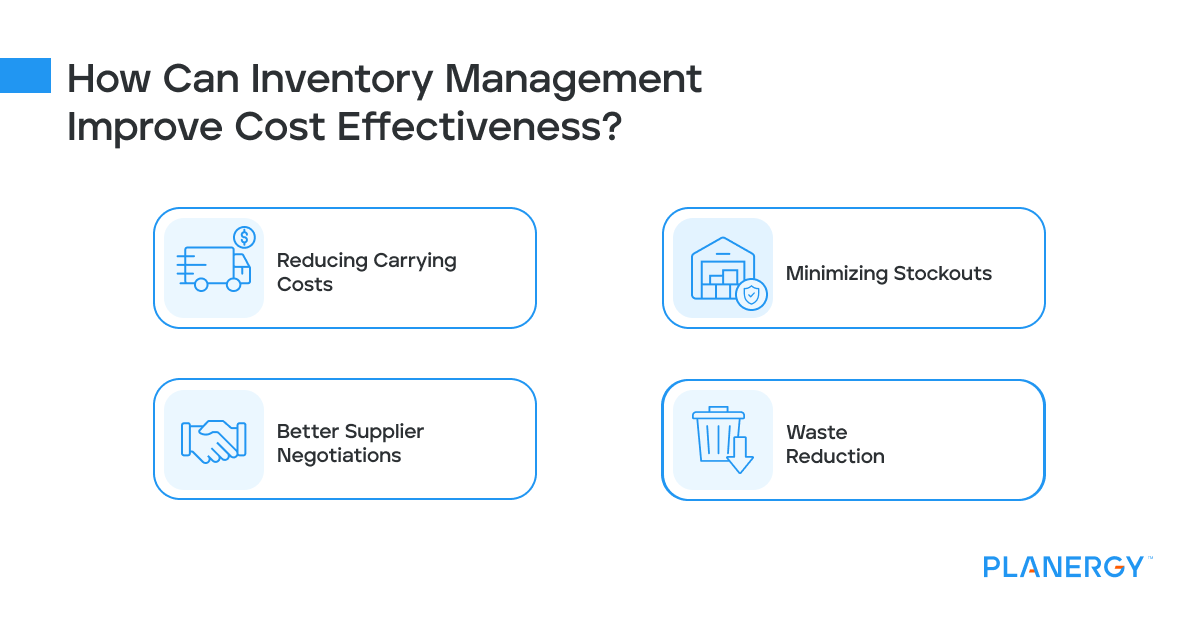
Reducing Carrying Costs
By optimizing inventory levels, businesses can lower the costs associated with storing excess inventory, including storage, insurance, and taxes.
This reduction in carrying costs frees up capital that can be redirected into other operational areas or investments, enhancing overall financial health.
Minimizing Stockouts
Ensures that products are available for sale, reducing lost sales and the potential loss of customers to competitors.
Adequate stock levels mean customers can always find what they need, improving satisfaction and loyalty while capturing more sales opportunities.
Better Supplier Negotiations
Accurate inventory data allows businesses to negotiate better terms with suppliers based on purchasing patterns and volume requirements.
This can lead to discounts, better payment terms, and more favorable delivery schedules, ultimately reducing procurement costs.
Waste Reduction
Proper inventory management reduces the risk of obsolescence and spoilage, which is particularly important for perishable goods.
By accurately matching supply with demand, businesses can minimize waste, ensuring that products are sold before they become outdated or unusable, thus preserving resources and capital.
Does ERP Help with Inventory Management?
Yes, an Enterprise Resource Planning (ERP) system can significantly aid inventory management by:
Integration
ERP provides a centralized platform integrating various business processes, including inventory management, procurement, sales, and finance.
This integration ensures that all departments can access real-time data, leading to better coordination and decision-making across the organization.
Real-Time Data
ERP systems offer real-time visibility into inventory levels, helping make informed decisions promptly.
This immediacy allows businesses to respond quickly to changes in demand, avoiding both stockouts and overstock situations and ensuring that inventory levels are always optimized.
Automation
ERP systems automate routine tasks such as reordering, stock level monitoring, and reporting, reducing manual errors and saving time.
Automation streamlines these processes, allowing employees to focus on more strategic activities and reducing the likelihood of human error.
Forecasting
ERP enhances forecasting accuracy through advanced analytics and historical data analysis, leading to better demand planning and inventory optimization.
By leveraging predictive analytics, businesses can anticipate market trends and adjust their inventory accordingly to avoid shortages without having an excessive amount of inventory.
Scalability
ERP supports business growth by easily scaling inventory operations as the business expands.
Whether a company is opening new locations, launching new products, or entering new markets, an ERP system can adapt to these changes smoothly, ensuring that inventory management processes remain efficient and effective.
Best Practices for Effective Inventory Management
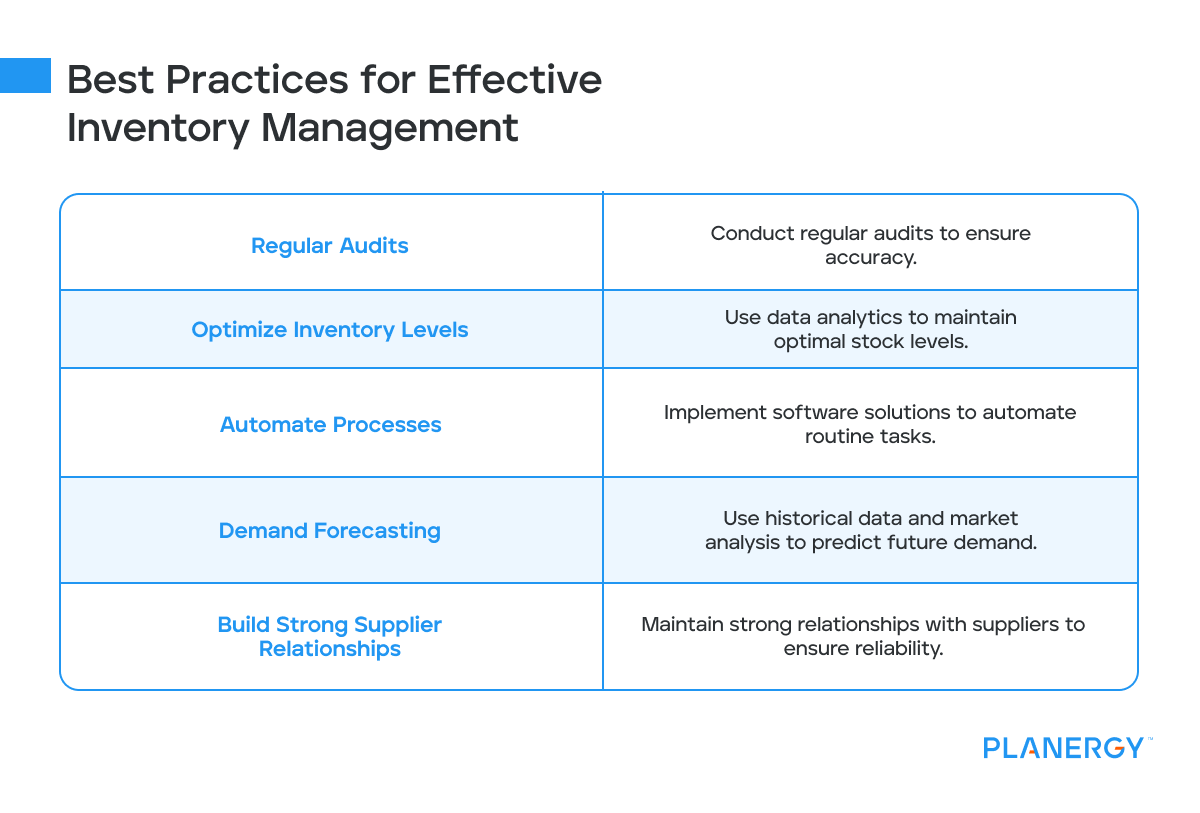
- Regular Audits: Conduct regular audits to ensure accuracy.
- Optimize Inventory Levels: Use data analytics to maintain optimal stock levels.
- Automate Processes: Implement software solutions to automate routine tasks.
- Demand Forecasting: Use historical data and market analysis to predict future demand.
- Build Strong Supplier Relationships: Maintain strong relationships with suppliers to ensure reliability.
Common Challenges in Inventory Management
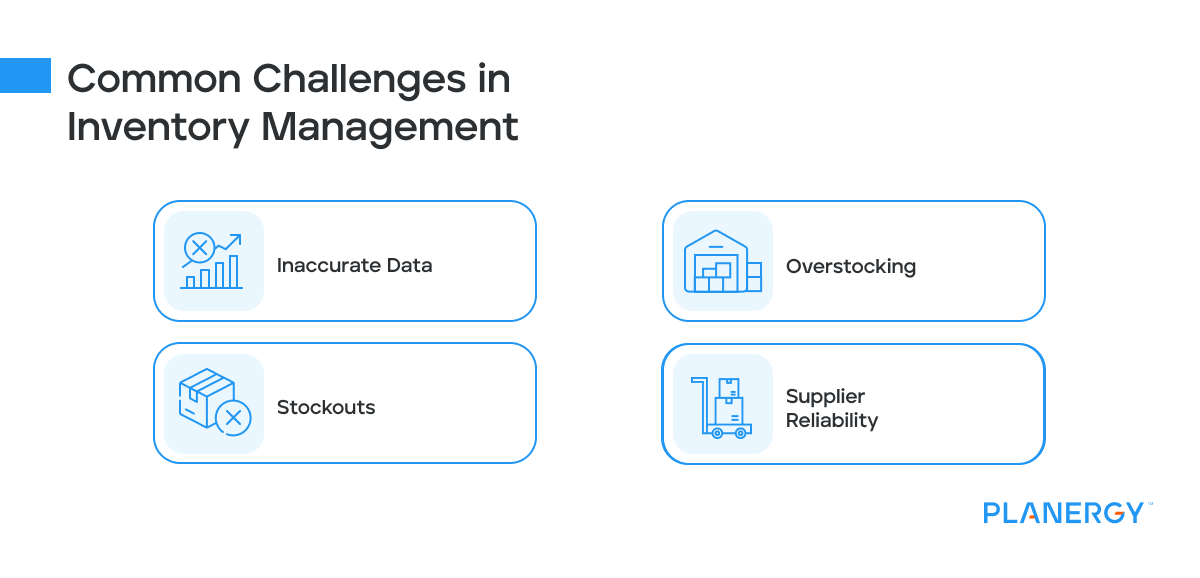
Inaccurate Data
Inaccurate inventory data can lead to poor decision-making, stock discrepancies, and inefficiencies throughout the supply chain.
To combat this, implement robust inventory management systems that use barcodes, RFID technology, or other automated tools to ensure precise record-keeping.
Regular audits should be conducted to reconcile the physical inventory with recorded data.
Periodic cycle counts – where a portion of the inventory is counted on a rotating cycle – can help maintain accuracy without requiring extensive, time-consuming full inventory counts.
Training staff on proper inventory handling and data entry practices is also crucial for maintaining accurate records.
Overstocking
Overstocking ties up capital in unsold products increases storage costs, and raises the risk of inventory obsolescence, especially for perishable or seasonal items.
To avoid this, use demand forecasting techniques to predict future sales based on historical data, market trends, and seasonality.
Adjust safety stock levels accordingly to buffer unexpected demand while avoiding excess stock.
Use advanced inventory management software to help you analyze patterns and optimize stock levels.
Regularly review and adjust reorder points and quantities to align with current demand to reduce the likelihood of overstock.
Stockouts
Stockouts occur when there is insufficient inventory to meet customer demand, leading to lost sales, dissatisfied customers, and potential damage to the brand’s reputation.
Monitor inventory levels in real-time using automated inventory management systems that provide up-to-date information on stock status.
Set automatic reorder points, which trigger purchase orders when inventory levels drop below a predefined threshold.
This ensures timely replenishment and minimizes the risk of running out of stock. Additionally, maintaining safety stock levels as a buffer against unexpected spikes in demand can further prevent stockouts.
Collaborating closely with suppliers to ensure reliable and timely deliveries is also essential.
Supplier Reliability
Unreliable suppliers can cause delays, quality issues, and supply chain disruptions, impacting inventory availability.
Diversify your supplier base to avoid dependency on a single source.
Having multiple suppliers for critical materials ensures that if one supplier fails to deliver, others can fill the gap, reducing the risk of supply chain interruptions.
Maintain strong relationships with key suppliers by fostering open communication, negotiating favorable terms, and collaborating on demand planning.
Long-term partnerships with reliable suppliers can lead to better service and consistent quality.
Regularly assess supplier performance and have contingency plans for emergencies, such as alternative suppliers or increased safety stock for high-risk items.
Cost-Effective Inventory Management Techniques for Small Businesses
Use Free or Low-Cost Software
Leveraging free or inexpensive inventory management tools can provide small businesses with the functionality they need without the financial burden of expensive software solutions.
Implement JIT
This lets you order materials as they’re needed in the production process to reduce storage costs and minimize excess inventory.
Bulk Purchasing
Negotiating bulk purchase discounts with suppliers can help small businesses reduce costs by buying larger inventory quantities at lower unit prices.
Cycle Counting
Cycle counting involves regularly counting a portion of your inventory rather than conducting large-scale audits. This method helps maintain accuracy and ensures discrepancies are identified and addressed promptly.
Inventory Management for Inventory Control
Effective inventory management is essential for the success and growth of any business, especially for small businesses seeking to maximize operational efficiency and minimize costs.
By leveraging free or low-cost inventory management software, implementing JIT methods, negotiating bulk purchase discounts, and utilizing cycle counting, businesses can maintain accurate inventory levels, reduce unnecessary expenses, and improve customer satisfaction.
Addressing common challenges such as inaccurate data, overstocking, stockouts, and supplier reliability with proactive strategies further enhances inventory management practices.
As technology advances, staying informed about the latest trends and integrating modern tools like ERP systems can provide a competitive edge.
Adopting these cost-effective techniques and best practices will help businesses optimize their inventory management processes, ensuring they meet demand effectively while maintaining financial health.

